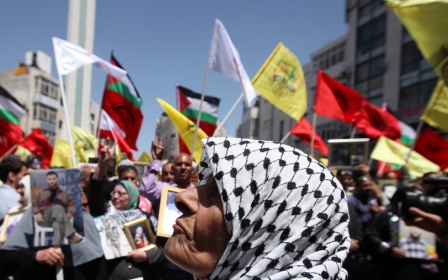Exclusive: When Palestinian prisoners slip through the net

When Palestinians get arrested by the Israeli authorities, their first stop is an interrogation centre. Sometime later, as little as a few hours or as much as three months - during which time they are regularly denied access to lawyers and medical care – they are moved to a detention facility for their trial. Only then do they enter the prison system proper.
Along the way, some disappear from the records.
International debate over Palestinians prisoners sparked by the cancellation of a scheduled prisoner release in late March overlooked one major detail: The lack of publically available data on how many Palestinians are arrested and detained each month by the Israeli authorities.
The Palestine Liberation Organization and various Israeli and Palestinian NGOs collect such data, but this is not seen as authoritative. The few who do know exact numbers, including the Israeli Prison Service (IPS) itself, won’t reveal them.
“Unless we know the exact number of arrests, we don’t really know what we’re dealing with,” Gavan Kelly, advocacy director at the Palestinian NGO Addameer, told Middle East Eye.
Stay informed with MEE's newsletters
Sign up to get the latest alerts, insights and analysis, starting with Turkey Unpacked
Addameer is one of the organizations that tries to monitor arrests and imprisonments, but as a Palestinian organization they can’t request the figures under Israel’s 1998 Freedom of Information Law (FOIL).
Groups say that the figures produced by FOIL requests are inaccurate. Itamar Barak, a data coordinator at the Israeli human rights organization B’tselem, says that since 2005 his organisation has sent monthly FOIL requests to the Israeli Prison Service (IPS) asking for updated information on detentions. The IPS numbers, however, don’t quite add up and are viewed with suspicion by the rights group.
“In the data I receive, there are contradictions,” Barak told MEE.
Barak compared a data set he received from IPS for February 2014 to the monthly data sent to Defence For Children International (DCI), an NGO that gathers data on detained minors through similar FOIL requests. The documents are both official data releases from the prison service and cover the same period of time, but differ in the numbers they report.
In the February data sent to B’tselem, the number of detainees under the age of 18 is listed at 210; 182 between 16-18 years old, and 28 between 14-16. But in the equivalent data sent to DCI, the total was listed as 230.
Ayed Abu Eqtaish, accountability programme director at DCI, told MEE that he hasn’t been able to find an answer for the contradictory data.
“We called the Israeli Prison Service and informed them that we received different numbers from B’tselem,” said Abu Eqtaish. “The lady there [responded] that she didn’t provide B’tselem with information.”
There’s no way to independently verify the numbers because IPS is the only organization that tracks them, he added.
Barak also cited instances of discrepancies within individual documents that list the number of Palestinians in administrative detentions – an Israeli legal procedure for holding suspects, sometimes indefinitely, without initiating criminal charges. He noted one occasion when he was able to identify an administrative detainee and discovered that the man didn’t appear in IPS’ monthly reports until several months after his detention. In other cases, Barak said, the number of administrative detainees might be listed in multiple sections of the same report with different figures.
Uncertainty over arrests and imprisonments affect wide swaths of Palestinian society. Some 800,000 Palestinians have been detained by the Israeli authorities since 1967, which means that 40 percent of all Palestinian men have been arrested at least once.
Official numbers on these arrests often come from the monthly data put out by the Palestinian Liberation Organization’s Negotiations Support Department, which tries to monitor arrests independently.
Sara al-Husseini, a communications adviser in the Negotiations Support Department, told MEE in an email that the PLO’s data comes from the Palestine Monitoring Group, which in turn draws its numbers from intelligence reports of the Palestinian security forces.
But a researcher at Addameer, who requested anonymity because of the politically sensitive nature of her work, found that these reports may substantially underestimate the real number of arrests in the West Bank and Gaza.
After scouring daily media reports of arrests and cross-checking the monthly tallies released by the PLO and the Applied Research Institute - Jerusalem, she came up with a list of detainee names for January 2014 totalling 655 people. The PLO’s list for the month was significantly lower, and counted only 529.
Even the longer list may undershoot the actual numbers. Addameer’s preliminary investigations for the researcher’s comparison involved interviews with the families of detainees at Ofer military court near Ramallah. In most cases, Addameer’s researcher told MEE that the detainees whose families waited at Ofer were not reported in the media.
“I would say only about 25 percent of the cases documented on the ground...were actually reported,” said the researcher.
Only detainees whose arrests were picked up in media reports and independently verified made it into Addameer’s list. As a result, the researcher estimates that Addameer’s number could undershoot the real value by anywhere from 25 to 200 percent.
“It’s a huge range, but you literally can’t get better data than that,” the researcher said.
Still the data produced by Addameer demonstrated that the numbers from the PLO and the various NGOs that track these figures are unreliable, she added.
Kelly, Addameer’s advocacy director, agreed. “None of these organisations can put a correct number on the arrests,” he said.
One of the problems with putting together accurate figures is deciding what counts as detention. Many Palestinians arrested by the Israeli authorities are held for only a few hours at a time and never progress beyond the interrogation centres or smaller interrogation rooms set up at checkpoints and Israeli settlements in the West Bank.
In a September 2013 incident in Hebron for instance, in which an Israeli soldier was shot and killed following intense clashes, approximately 80 Palestinians were arrested but more than 1,000 people were temporarily detained, during which time they were shackled and interrogated in the city square.
DCI’s Abu Eqtaish noted that the number of temporary detentions have increased in recent years. According to him, DCI used to send lawyers to Israel’s interrogation centres at the end of each month to obtain counts of detained children, but they no longer do so because the detainees are rarely held long enough to make it into the end of month data.
“Nobody knows [how many are detained] because usually they just keep them for a few hours,” Abu Eqtaish told MEE.
Mourad Jadallah, a legal researcher at Addameer, agrees.
“It’s very hard to figure out the real number [of temporary detentions],” he said.
While these cases are not counted, they can still be traumatic. Reports of interrogations, both during temporary detentions and longer prison terms, often depict the use of torture techniques on detainees.
According to Kelly, since 1967 244 Palestinians have died in Israeli custody, with the issue rising to the surface again last February following the death of Arafat Jaradat. The 30-year-old Hebronite died while being interrogated for allegedly throwing stones and a Molotov cocktail at Israeli soldiers. The incident sparked outrage among Palestinians after autopsy reports pointed to torture as the possible cause of death.
Those who are detained for longer periods of time though remain the most at risk.
Salah Hamouri, a French-Palestinian affiliated with the leftist Popular Front for the Liberation of Palestine, was charged with intention to assassinate the leader of Israel’s ultra-orthodox Shas party. He was imprisoned for seven years in Israel, including a three month stint in the notorious Moscovia interrogation centre, a facility located in an imperial Russian church in West Jerusalem that also houses Jerusalem’s police station.
“For the first 60 days, I was isolated,” Hamouri told MEE. “They interrogated my father...it was one of the pressures on me.”
Hamouri helped to organize a 15-day hunger strike leading up to his release as part of the Gilad Shalit prisoner exchange in late 2011. During the strike, he said, all lawyer and parental visits were cut off, and he was regularly shackled and transported in metal buses for hours at a time, without access to bathrooms. Ten years ago, Hamouri said, the prison system stopped allowing salt to hunger strikers, a medical necessity when fasting for long periods.
“The people decide to organise these hunger strikes, because they are looking for a human life in prison,” Hamouri said. “You have your stomach and your will. This is your only [weapon]: your stomach and your will. And you are facing the state of Israel with this.”
According to both Kelly and Barak, the Israeli Prison Service alerts only one organisation of detentions as they occur: the International Committee of the Red Cross, which like IPS doesn't publish data on arrests. Calls to both organisations to request information on detention totals were deflected.
"We receive a notification of people present in detention, but for numbers of detainees in Israeli prisons you should ask the detaining authorities,” Jon Larsen, a media contact at ICRC’s Jerusalem mission, told MEE.
An official of the Israeli Prison Service who oversees Freedom of Information Law applications did not respond to several requests for comment.
Barak said he thinks IPS may themselves be unaware of the exact figures. “I’m not totally sure they’re hiding...it might be just lousy work,” he said. “It is possible that they have lousy computer systems or databases, so it’s not intentional. It’s just mistakes.”
However, Kelly pointed out the benefit to IPS in withholding the data. “At the end of the day, Israel wants to hide its actions from international view.” he said.
If Addameer or other organisations had access to the numbers, Kelly continued, “we would be able to expose the true reality of the occupation.”
“We need to know what’s happened here,” he said.
Middle East Eye delivers independent and unrivalled coverage and analysis of the Middle East, North Africa and beyond. To learn more about republishing this content and the associated fees, please fill out this form. More about MEE can be found here.




